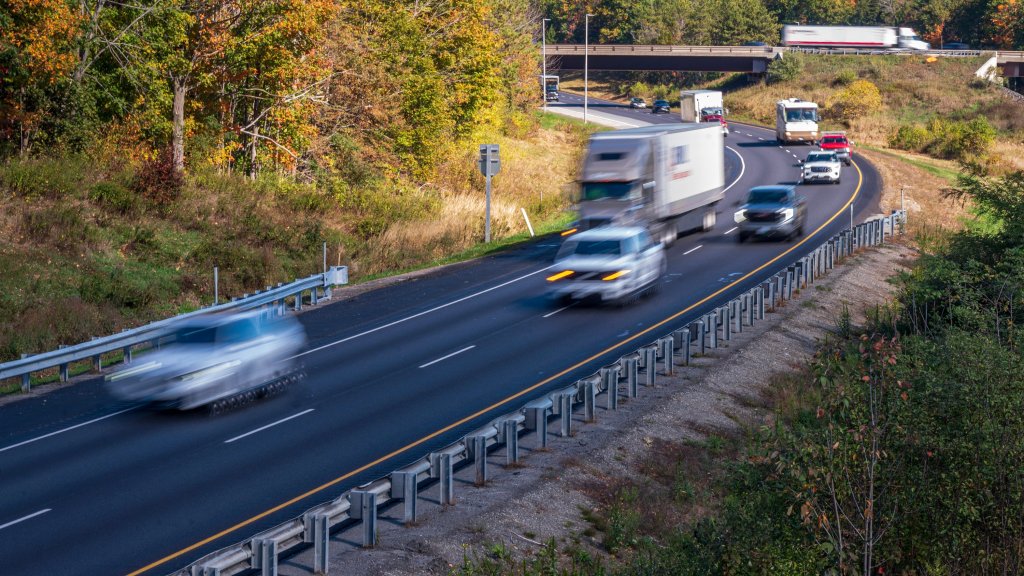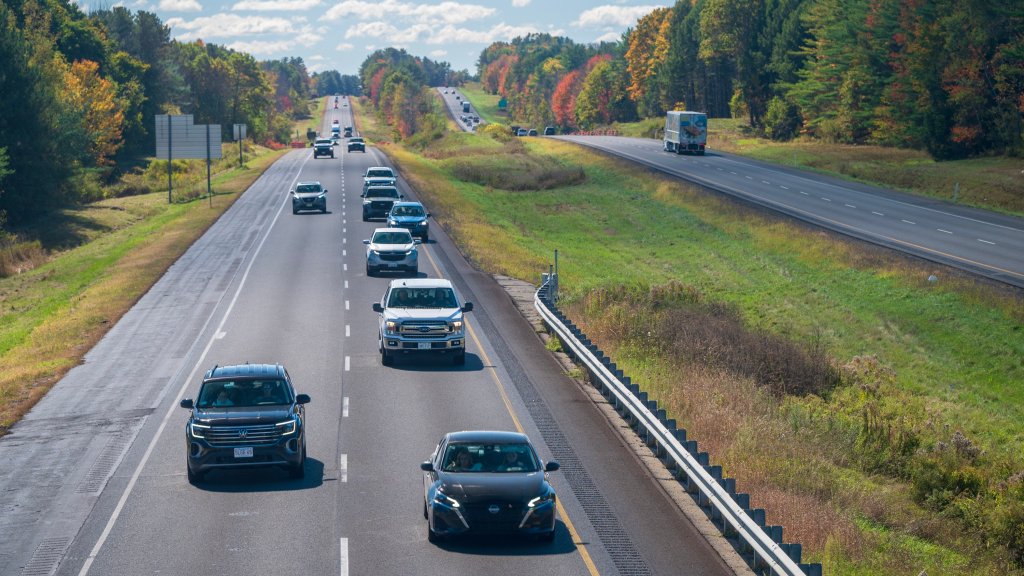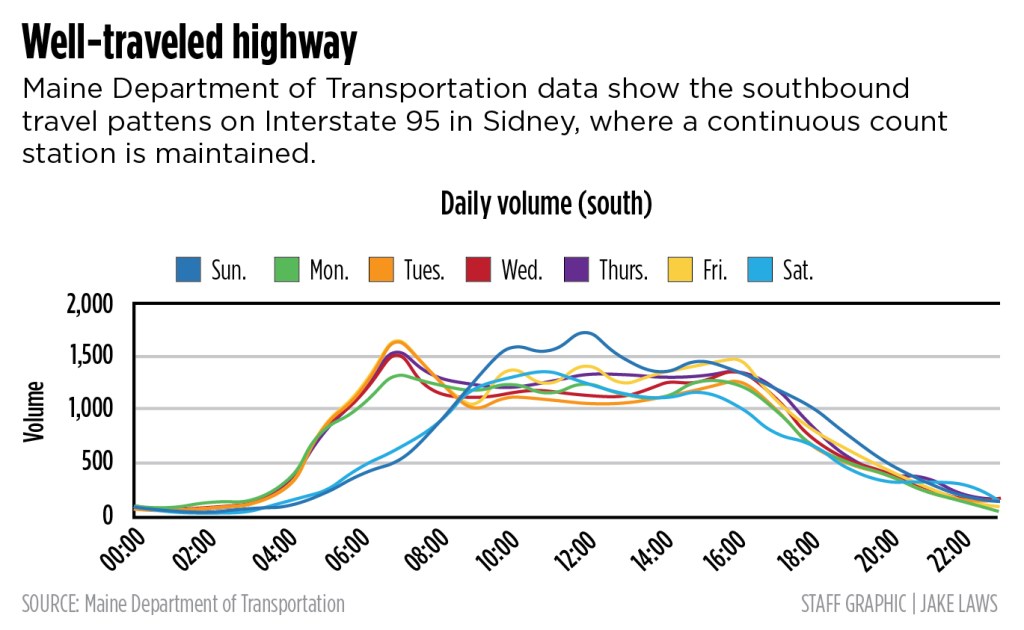
Matthew Marshall is horrified at what he sees happening on Interstate 95 between Waterville and Augusta as he drives to work in Bath from his home in Ripley.
During his 200-mile round-trip commute, he witnesses crashes and angry, distracted and impatient drivers, many of whom travel well beyond the speed limit, frequently over 90 mph.
But nowhere is it worse than the 20-mile stretch between Augusta and Waterville, in both directions, according to Marshall, 57.
“That is what I consider the death zone,” he said.
While only one of Maine’s 141 fatal crashes to date this year was reported on that stretch of the interstate in January, summer travelers in both directions have experienced delays from collisions and crashes.
Maine Department of Transportation data show 72 crashes occurred during the 92 days between July 1 and Sept. 30 on I-95 between Fairfield and Hallowell, a crash about every 1.3 days. Of that number, 15 were rear-end crashes caused when drivers followed other vehicles too closely and 14 occurred in or near work zones, according to data compiled from police department reports.
Thirteen of the 72 were sideswipe crashes related to drivers failing to yield or stay in the proper lane, and four were in or near work zones. Distracted driving contributed to 11 crashes; eight involved animals; and the rest were related to operating under the influence, falling asleep, hydroplaning where operators drove too fast for conditions, and crashes where operators drove in an “erratic, reckless, careless, negligent or aggressive manner,” DOT information states.
Marshall, who enters I-95 near Pittsfield in the morning, has seen just about all of it.
Marshall’s wife, Lori, 49, usually travels with him, as she works in the Brunswick area. But one day when she drove herself to work, she encountered a pickup truck with a cast-iron skillet on its grill. The skillet flew off and shattered her windshield, she said.
“Last week, we literally saw someone swerving in the breakdown lane several times,” Matthew Marshall said. “She was putting on her makeup in her mirror.”

“I think it has everything to do with the people. They’re taking risks they don’t need to be taking.”
Matthew Marshall
It is a high-traffic area, because many people live in Waterville and Augusta, and many commute to work in those cities, Matthew Marshall said.
He said he doesn’t fault state troopers who patrol that area because they are always there, watching. He doesn’t view the problem as being caused by how the interstate is set up, except for what he sees as a dangerous spot in Augusta where the on-ramp at Exit 112 near the Olive Garden restaurant flows into three lanes of traffic going north.
“It all boils down to people not driving smart,” he said. “I don’t think it has much to do with the environment. I think it has everything to do with the people. They’re taking risks they don’t need to be taking.”
He said if he could make one suggestion, it would be that police park their cruisers in places where they aren’t so visible, as that might make motorists think twice about breaking the law.
“Other than a state trooper or the police, there’s nobody more qualified than me to tell you what’s going on there,” he said.
CRITICAL TO DRIVE SAFELY
The state Department of Transportation maintains a continuous count station on the southbound lanes of I-95 north of the Lyons Road exit that shows peak traffic on the southbound side typically occurs around 7 a.m., except on weekends when peak happens around noon, according to the data. The DOT doesn’t keep hourly traffic counts for the northbound lanes.

Andrew Gobeil, director of DOT’s office of communications and creative services, said volumes can vary significantly from exit to exit, particularly within Waterville, where residents often use I-95 to get to the other side of the city.
“One crash in a work zone is one too many,” Gobeil said Wednesday in an email.
He said work zones are dynamic environments that require everyone to practice safe habits.
“Among Maine DOT’s top priorities is to enhance safety in all aspects of our work with special attention being paid to work zones,” Gobeil said.
Lauren Stewart, director of the Maine Bureau of Highway Safety, which is part of the Maine Department of Public Safety, said officials see a crisis in fatal motor vehicle crashes.
DOT officials do a lot of public outreach, including issuing news releases, being available for media inquiries about projects, placing message boards on roads well in advance of work zones and using safety flaggers, Gobeil said. They work with transportation colleagues and researchers across the industry to monitor best practices about messaging drivers.
State officials also post on social media, which is where many travelers go to find out why traffic is backed up.
Maine State Police posted a traffic alert on its social media site at 2:56 p.m. Oct. 3 that states: “I-95 going northbound in Augusta (mile marker 110-111) is completely shut down right now due to a series of accidents. We expect to be able to clear the area soon, but for the time being please avoid the area.”
It was a popular post, with many commenting the area between Waterville and Augusta is dangerous. As of Oct. 9, the post had received 358 hits, 181 comments and was shared 244 times.
“This year is on par to be equally as tragic as last year,” Stewart said earlier this month. “As of today, we have received fatal crash reports showing that 141 people have died on Maine roads since Jan. 1.”
Crash data, including fatalities, are tracked by the bureau. Comparing the number of traffic deaths that have occurred through Oct. 9 since 2021, according to the bureau’s database, there were 117 fatalities, 133 in 2022, 105 in 2023, and 144 in 2024.
“We see the same contributing factors in these fatal crashes — speed and aggressive driving, impairment, distraction, and lack of belt use. People are simply driving too fast and too aggressively and they are not paying attention to work zone speeds or signage, speed limit signs, they are using their phones, and they are impaired on drugs, alcohol, or a combination of both.
“The Bureau has created some new PSAs for television and radio, and we hope to have those out soon,” Stewart said. “We are in the process of offering grant opportunities for law enforcement agencies to conduct dedicated overtime details for these very behavioral issues that are contributing.”
‘IN A HURRY TO GET SOMEWHERE’
Like the Marshalls, Erica Lavallee-Gustafson travels on I-95, but not as often and not as far. She drives I-95 from her home in Waterville to Augusta two to three times a week. Before a year ago, she drove it many times during the 23 years she worked at MaineGeneral Health between the Augusta and Waterville campuses.
“I’ve witnessed multiple fender benders, along with others that end up in ditches,” Lavallee-Gustafson, 55, said. “Honestly, I can’t say there is one part of the stretch worse than another. I’ve had numerous discussions with people over the years about how that area seems to have a dark, looming cloud hovering over it.”
Lavallee-Gustafson said she thinks that as the population has increased, so has the traffic.
“Everyone is always in such a hurry to get somewhere, and the sense of entitlement that has encompassed our society makes everyone feel more important than the other,” she said. “I witness people not allowing people to merge onto the interstate when they clearly have room to move over, and let’s not forget about road rage. I set my cruise control on 72 and have people going much faster, weaving in and out of traffic, going against all laws of driving on the interstate.”
The development of additional on-ramps and exits add to already congested roads, full of people not paying attention and rushing, she said.
“Now with construction causing delays and long lines of congestion, people are getting frustrated for having to wait. You can drive along two miles and see the signs that there is construction ahead, and the lane is closed, yet you have people flying down the closure trying to squeeze in between other cars.”
She said she recently witnessed an incident involving aggressive hand gestures and yelling because of that very situation.
“The amount of accidents are increasing and becoming more tragic,” she said. “I don’t necessarily blame the construction. I know it’s work that has to be done, but it doesn’t help.”

We invite you to add your comments. We encourage a thoughtful exchange of ideas and information on this website. By joining the conversation, you are agreeing to our commenting policy and terms of use. More information is found on our FAQs. You can modify your screen name here.
Comments are managed by our staff during regular business hours Monday through Friday as well as limited hours on Saturday and Sunday. Comments held for moderation outside of those hours may take longer to approve.
Join the Conversation
Please sign into your CentralMaine.com account to participate in conversations below. If you do not have an account, you can register or subscribe. Questions? Please see our FAQs.